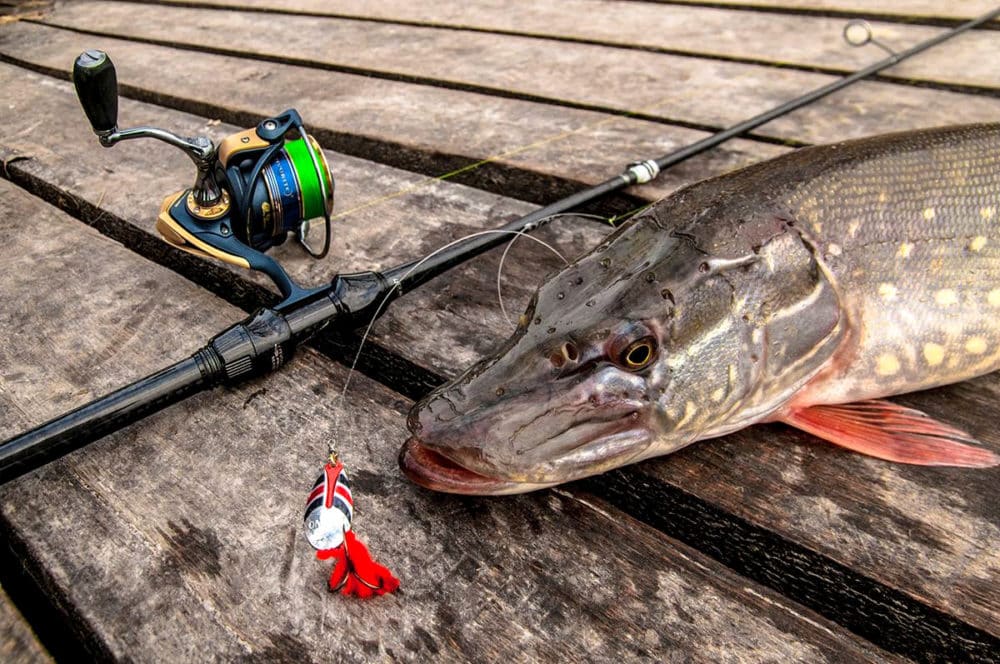The diverter leash belongs to the classic spaced rigs, most often it is a jig version. This type of installation is used if the fish ignores the usual silicone baits on jig heads and cheburashkas, or if, due to objective reasons (fishing conditions, season, current speed, the presence of a snag, bottom coating, etc.), the use of a diverter leash is the only effective one a way to lure the predator out of its hiding place. In the middle latitudes of the CIS and the Russian Federation, the diverter is most often used when fishing for perch, due to the peculiarities of its hunting, habits and habitats. We will talk about the features of the installation of a diverter leash on a perch, as well as the fishing process itself, and we will talk in this material.
- Why diversion – what are its advantages?
- How to make a diverter leash for a perch: necessary accessories, installation of equipment
- All methods of mounting a diverter leash on a perch with a photo
- Double swivel version
- Triple swivel as mounting base
- T-swivel
- About hooks
- About sinkers
- Baits used – what to look for
- Fishing for perch on a lead leash: tactics, postings, video tips
- Search tactics when fishing from the shore
- Tactics when fishing on a diverter from a boat
- Depending on the season – when is it better to use a perch lead
- What kind of spinning rod is needed for catching perch on a diverter leash
- Поделиться ссылкой:
Why diversion – what are its advantages?
Due to the fact that the load and the bait are separated in space, the rigging lead allows you to catch perch with small baits, but at a great distance. The load in no way interferes with the lure floating in the water column, without interfering with its animation and without reducing its attractiveness for fish, which cannot be said, for example, about articulated mounting. This is especially true when fishing from the shore in shallow areas and in large areas where long distance casting is needed, but in combination with a small lure of 1.5-3 inches. It is also worth noting that even having the opportunity to cast the bait with an ultralight tackle at a long distance, then it is not possible to perform the necessary “step” animation, due to the lack of contact with the micro-bait at long distances. Therefore, in such situations, the diverter helps out,which can be caught at any distance and with almost any lead weight.
Interesting to know! The diverter lead has been banned in many sporting events as it is believed to provide an unsportsmanlike advantage to the spinner who uses it. But we are hobby anglers and we shouldn’t give up rigs that can increase the chances of success.
It is also worth noting that in view of the fact that the bait has been largely removed from the weight, it is easier for a perch to chew, and therefore there are much less idle bites than on a deaf or articulated rig.
How to make a diverter leash for a perch: necessary accessories, installation of equipment
There are several options for rigging a diverter leash for catching perch, we will consider the main ones, evaluate the advantages and disadvantages of each of them. So, the main types of installation of a diverter leader are a loop on the main line, sliding in-line, on a double swivel, on a triple swivel.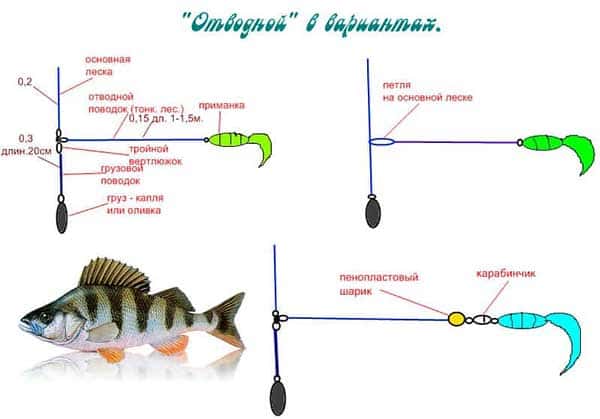
All methods of mounting a diverter leash on a perch with a photo
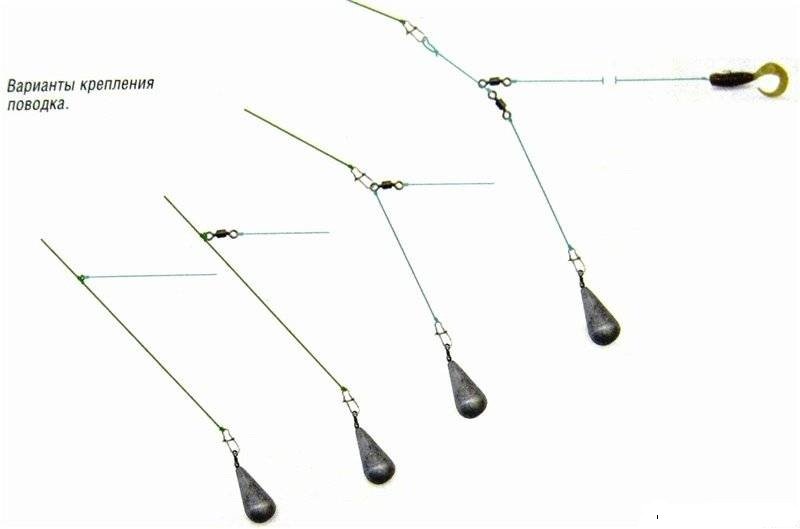
- A loop on a line is the simplest rig.
- A line swivel is a more advanced rig.
- Through the fastener – the bait is quickly replaced.
- Two swivels – sliding in-line rig.
The last option, in our opinion, is the most relevant and working. When biting, there is no resistance at all, and therefore even the most accurate predator will not feel the catch.
Double swivel version
The swivel is knitted with one end to the cord. A reserve is made of fluorocarbon with a length of 20-50 cm and a load is tied to it through a fastener. Fluor is needed for a dual purpose. The first – when fishing on a shell bottom, it will protect the cord from abrasion. And the second goal is that this version of the rig is less tangled than in the version when a swivel is simply tied to the cord. The bait is tied to the second eye of the swivel with a support of 60-100 cm, depending on the depth at which the fishing is going on, as well as on how active / passive the fish is. The more passive the perch, the longer the leash. Leash material – monofilament line, or fluor. Diameter 0.12-0.2 mm.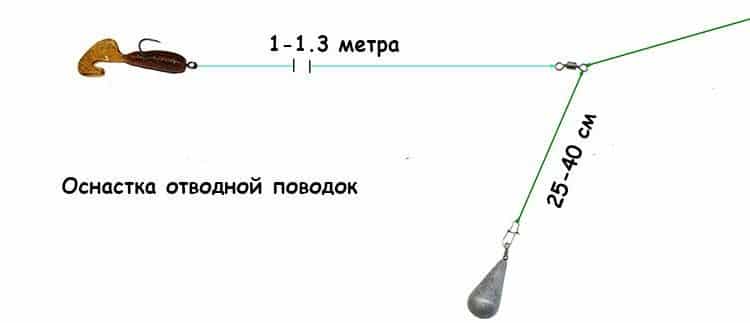
Triple swivel as mounting base
Each part of the triple swivel is tied with a main cord, a bait on a leash and a load on a support. Such installation is good in that it allows you to prepare the leashes at home and fasten them through the fastener on the pond without wasting time.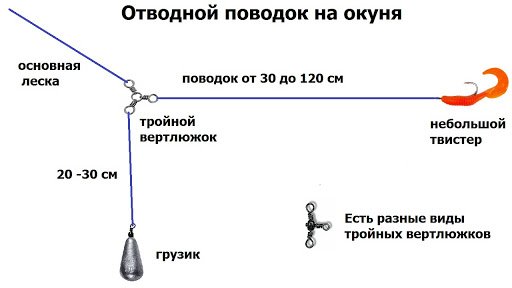
T-swivel
A sub-version of the installation from the previous version of the outlet leader rigging – a T-shaped swivel is used.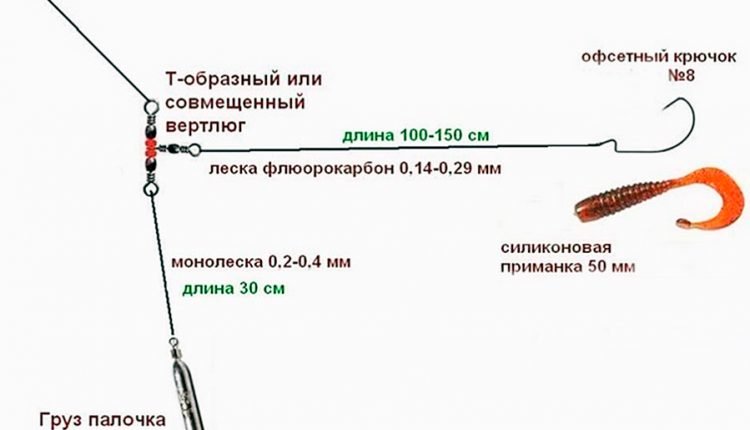
About hooks
More often, an offset hook is used to give the rig a non-snag factor. The size is matched to the bait, as with a conventional installation on an offset printer. You can also use regular big-ear hooks if the bottom is clean and you want to increase the grip with a sluggish bite. Good hooks Dekoy, Jamakatsu, Ovner. In addition to the fact that they are of high quality, these companies have hooks made of thin wire, which makes it possible to minimize the load of the bait itself and on the wiring it will hang and, as it were, float in the water column, and not fall to the bottom at a minimum pause in the animation.
About sinkers
The weights are selected based on how far you need to cast the bait and at what depth you are fishing. With standard depths in the region of 2-4 meters, the optimal weight is in the region of 8-12 grams. You can use the Floppy, dropshotovskie loads, olives and even Tyrolean coli: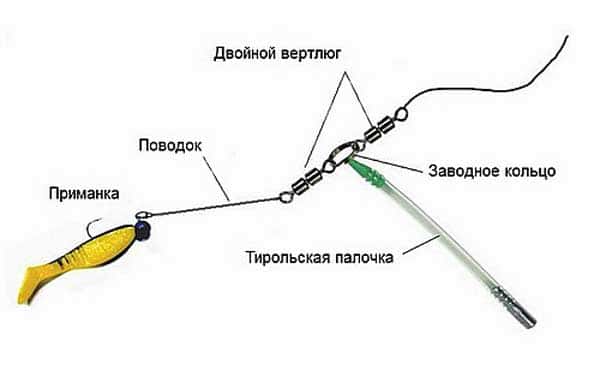
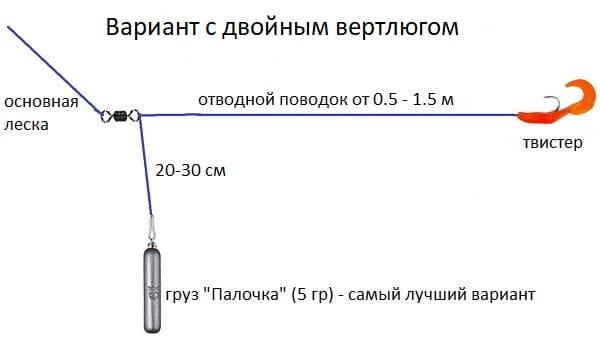
Baits used – what to look for
When fishing for perch on a lead leash, typical jig perch lures are used – edible slugs and worms, nymphs and crustaceans, twisters. Less often – small vibrotails.
spoons, wobblers. But less often than jig ones.
Fishing for perch on a lead leash: tactics, postings, video tips
The perch stays at the bottom for almost the entire season. In spring and autumn – always, in summer there are exceptions when a predator rises to the middle layers of the water area – in such cases, a pelagic jig should be used
… The retrieval of the diverter leash largely depends on the activity of the perch. The more active the predator, the more aggressive animation is needed. In very cold water (in early spring), perch are interested in passive lazy stretches with pauses; as the temperature warms, the diverter line can be carried out more aggressively with tosses and short pauses. In the “lazy season”, when the water, on the contrary, is very warm, the perch often falls into a stagnant state, especially in shallow water bodies, and then it is worth trying again to slow down all the animation phases. Short, unhurried pulls along the bottom of the load will give their results. Often the bite occurs on a pause, in which case you need to give the sailor how to swallow / chew the bait (and this is almost always an edible in one form or another) and only then do the hooking.
In the case of a weak bite or its absence, it makes sense to increase the pause between jerks to 6-8 seconds or more, as well as change the bait to a smaller one in length, or in terms of visual volume. For example, a twister for a slug in the same size in inches, or a three-inch bait for a two-inch one. This often produces dramatic results.
Twitch wiring is acceptable, on which the bait seems to be thrown to the sides, depicting a victim – a provocateur for a bite. You can lead the bait on a retraction leash and evenly, at the slowest speed.
Search tactics when fishing from the shore
The fisherman moves along the shore of the reservoir and catches perspective points with point casts in an arc of 180 degrees. It is important to be able to understand the nature of the bottom. This is achieved by experience, but there are general rules. So, on a lead-off leash, the muddy bottom is very well felt – the weight seems to fall into it and when it comes off, resistance is felt. If the load knocks clearly on the hand when it touches the bottom and comes off with a light movement – the bottom is sandy or shell rock. Perch, just prefers a sandy bottom with a shell and overgrown with grass. Avoids muddy areas. Also, the striped robber loves obstacles at the bottom – stones, driftwood, depressions and hills in the relief. Such places can be promising. It is not worth staying in one place for a long time, if the reservoir allows, then it is better to constantly shift in search of an active predator.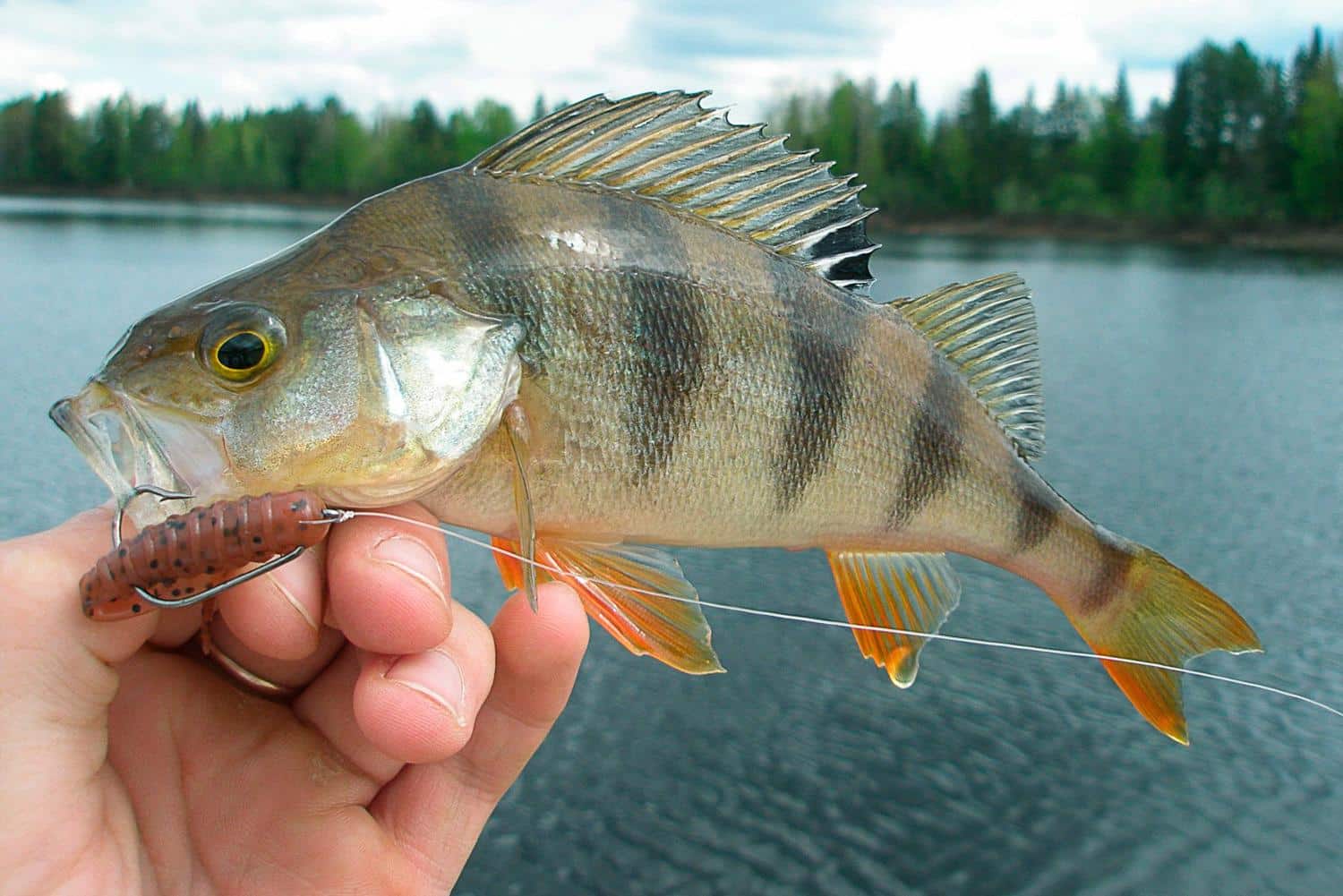
Tactics when fishing on a diverter from a boat
When fishing from a boat, the angler has more opportunities to approach a promising area and, what is important, to fish it from different angles. Changing the direction of the wiring often works well. In addition, it is worth noting that when fishing with boats, it is worth using a shorter rod than when fishing on shore. 2-2.40 meters will be enough.
It is interesting! To reduce the number of overlaps of the leash with bait and leash with a load to a minimum, you need to follow three simple rules:
- The thickness of the leash with the load must be greater than the diameter of the leash with the bait.
- The length of the leash with a load is less than the length of the leash with a bait.
- When splashing the rig into the water, you need to give a slight stretch of the cord, then the bait in an arc will go away from the load.
Depending on the season – when is it better to use a perch lead
Especially effective is perch fishing on the diversion spring and autumn in cold water, when the sailors stay at the bottom of the reservoir, since the diverter rig is intended for catching the bottom water horizon. There are also nuances. So, for example, in late April-early May, the perch has a spawning season, it rubs in shallow areas of the reservoir that are already warmed up and where you can also successfully use a diverter leash, although a hinged installation will also be appropriate if fishing is carried out at short distances. Well, we are looking for a solid bottom and fry. These are the places the striped robber prefers. Catching perch on a diverter leash from the shore in spring in cold water – video from the champion of Ukraine and the world in spinning fishing: https://youtu.be/1IRejWrVTn8 So, you can improve the nibble of perch when fishing on a diverting leash using the following methods:
- increase the leash length;
- reduce the size of the bait;
- change the place of fishing;
- make the animation slower – increase the pauses, all movements are smooth and lazy.
What kind of spinning rod is needed for catching perch on a diverter leash
Our opinion is that it is better to use light tackle with a test in the range of 2-10, 3-15 grams for catching perch on a diverter lead. This is the optimal perch test in most cases. A sonorous and sensitive tip is imperative, since the behavior of the bait and bite must be monitored exactly at the tip of the blank.
For fishing on the current, a blank with a large dough is usually taken, since larger weights are required so that the bait does not immediately take off from the perspective fishing point.
Build – fast. Length 2.1-2.4 meters. Reel 2000-2500 according to Shimano classification. A thin braid to match the entire tackle, a mono line for the diverter is not the best option. A perch diameter of 0.08-0.12 is sufficient. The line is as slippery as possible to increase the reach of the bait.
If you plan to fish at great depths and with heavier weights, then the test is selected for the necessary conditions. Depending on the situation, this can be a test of 5-25 grams or more.
Thus, the diverter leash is a quality rig for spinning perch, but not a panacea and not the best of the best. This is just one of the tools that can and should be used when catching a striped predator in some of the conditions and situations listed above.




